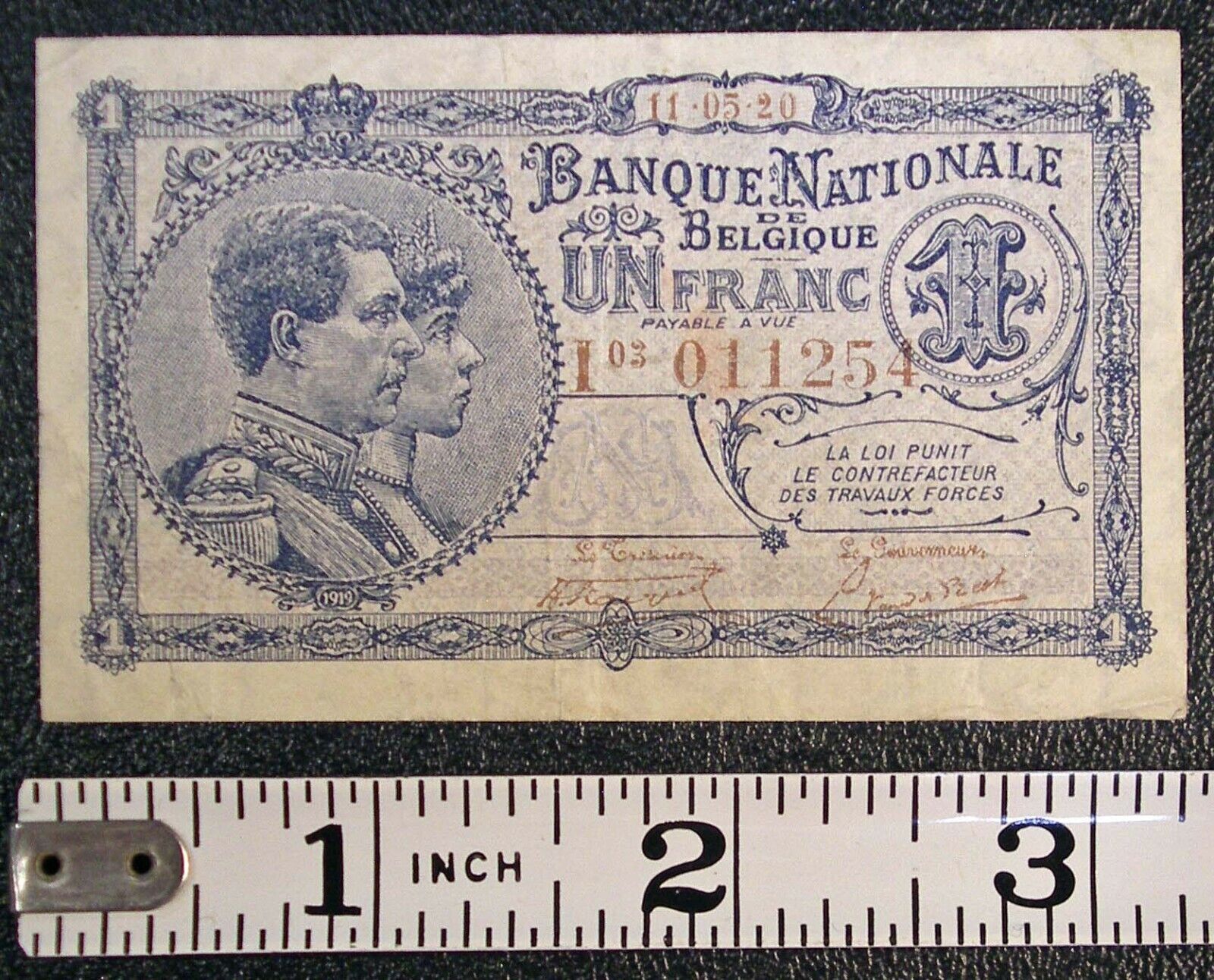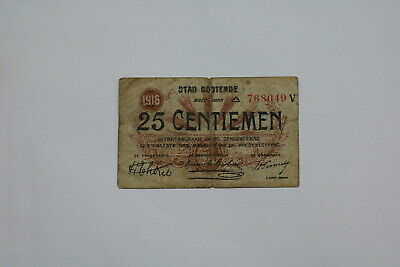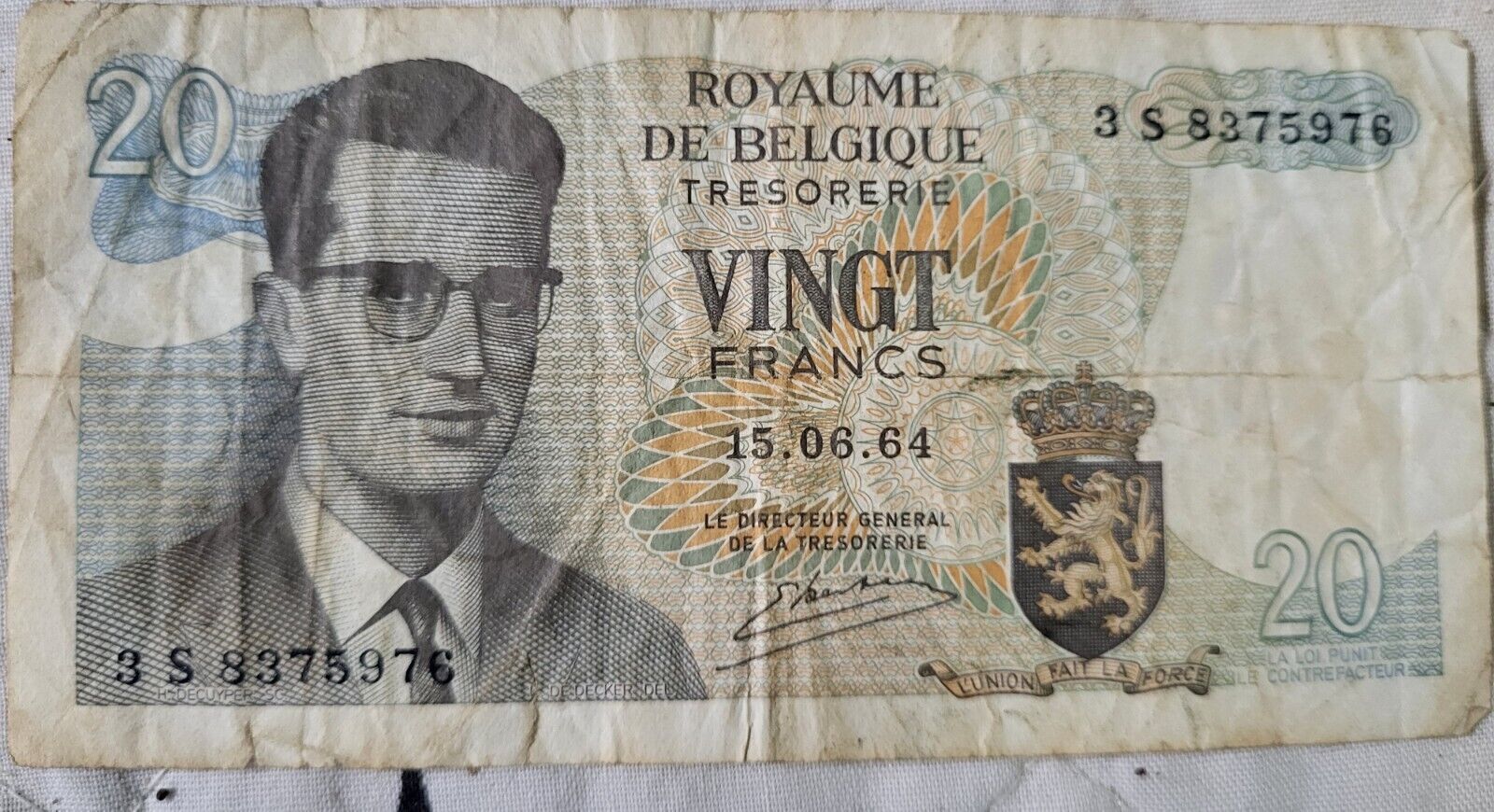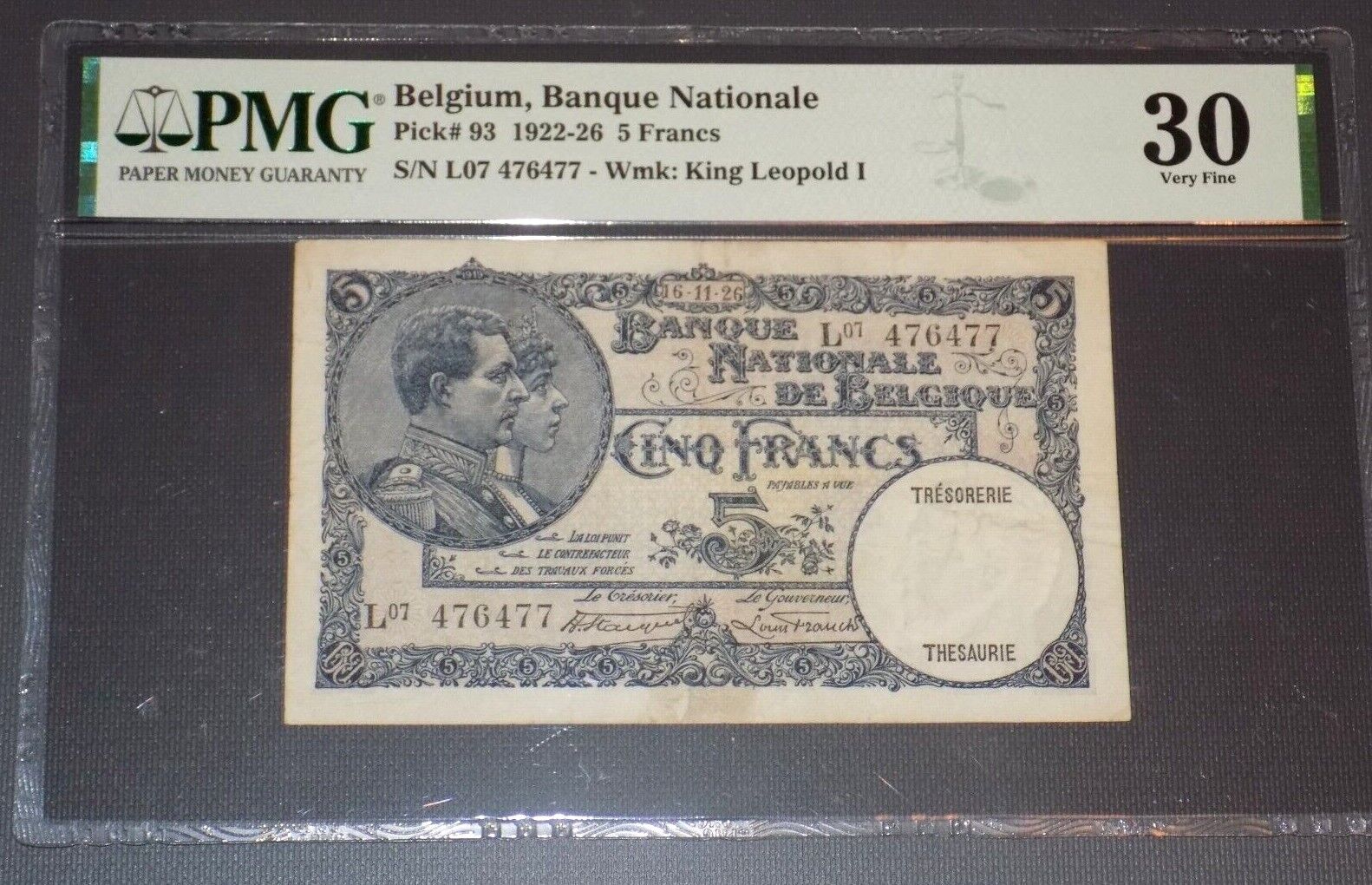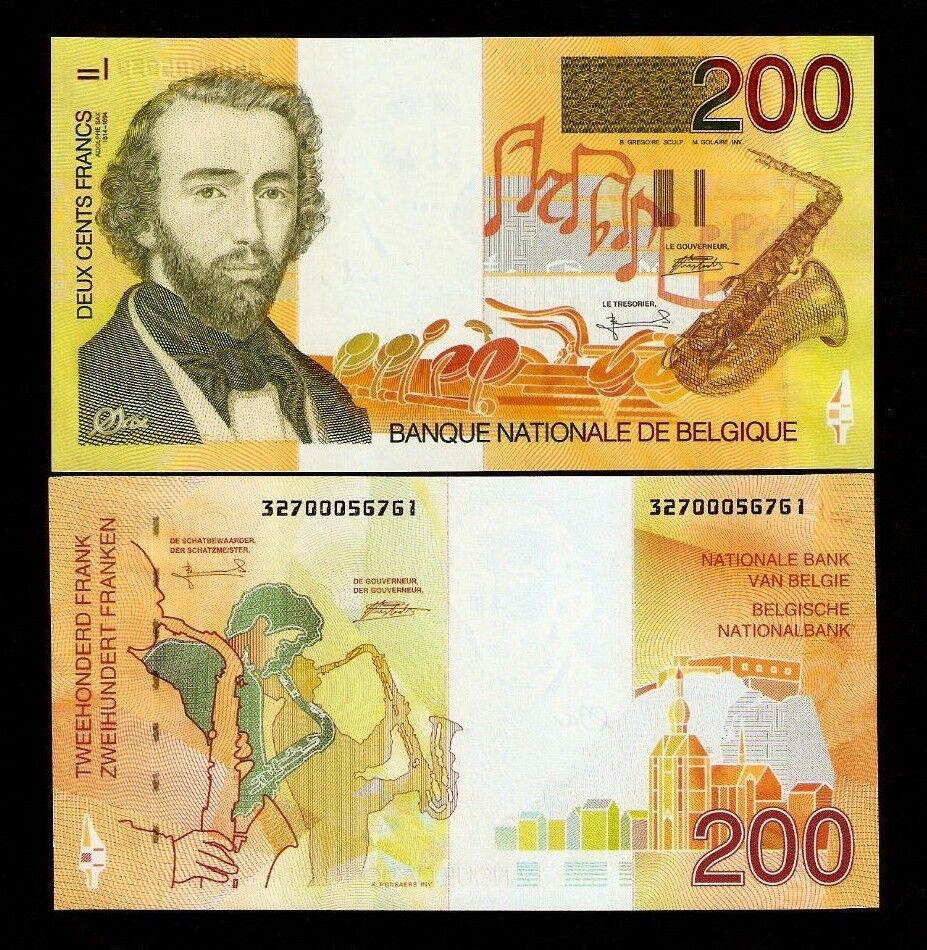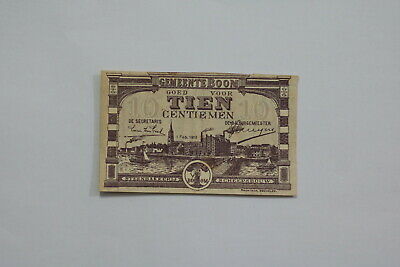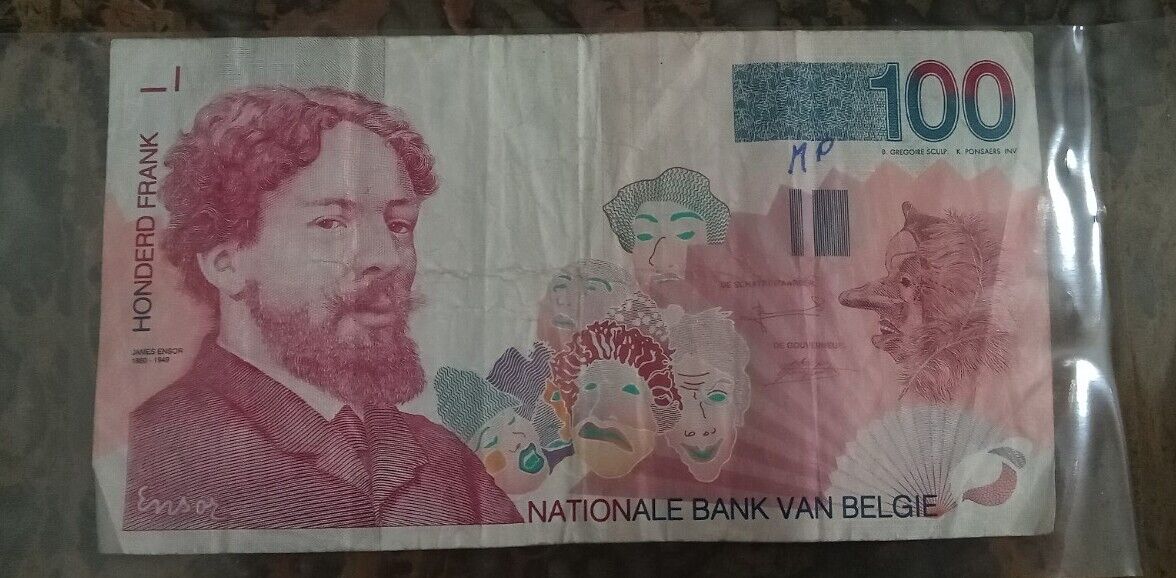-40%
Belgium banknote - 5 cinq francs - year 1926 - King Albert and Queen Elizabeth
$ 11.61
- Description
- Size Guide
Description
The Belgian franc (French: Franc belge, Dutch: Belgische frank, German: Belgischer Franken) was the currency of the Kingdom of Belgium from 1832 until 2002 when the Euro was introduced. It was subdivided into 100 subunits, known as centimes (French), centiem (Dutch) or Centime (German).The conquest of most of western Europe by revolutionary and Napoleonic France led to the French franc's wide circulation. In the Austrian Netherlands (the current Belgium), the franc replaced the kronenthaler. This was in turn replaced by the Dutch guilder when the United Kingdom of the Netherlands was formed.
Following independence from the Kingdom of the Netherlands, the new Kingdom of Belgium in 1832 adopted its own franc, equivalent to the French franc, followed by Luxembourg in 1848 and Switzerland in 1850.
Belgian mint working during the late 19th century was innovative and Belgium was the first country to introduce coins made of cupronickel, in 1860.
In 1865, Belgium, France, Switzerland and Italy created the Latin Monetary Union (to be joined by Greece in 1868): each would possess a national currency unit (franc, lira, drachma) worth 4.5 g of silver or 290.322 mg of fine gold, all freely exchangeable at a rate of 1:1. In the 1870s the gold value was made the fixed standard, a situation which was to continue until 1914.
In 1926, Belgium, as well as France, experienced depreciation and an abrupt collapse of confidence, leading to the introduction of a new gold currency for international transactions, the Belga worth 5 francs, and the country's withdrawal from the monetary union, which ceased to exist at the end of the year. The Belga was tied to the British pound at a rate of 35 belgas (175 francs) = 1 pound and was thus put on a gold standard of 1 Belga = 209.211 mg fine gold. The 1921 monetary union of Belgium and Luxembourg survived, however, forming the basis for full economic union in 1932. In 1935, the Belgian franc was devalued by 28% to 150.632 mg fine gold and the link between the Luxembourg and Belgian francs was revised to 1 Luxembourgish franc = 1 1⁄4 Belgian francs.
Following Belgium's occupation by Germany in May 1940, the franc was fixed at a value of 0.1 Reichsmark, reduced to 0.08 Reichsmark in July 1940. Following liberation in 1944, the franc entered into the Bretton Woods system, with an initial exchange rate of 43.77 francs = US dollar set on October 5. This was changed to 43.8275 in 1946 and then to 50 following the devaluation of the British pound in September 1949. The Belgian franc was devaluated again in 1982.
Like 10 other European currencies, the Belgian/Luxembourgish franc ceased to exist on January 1, 1999, when it became fixed at 1 EUR= 40.3399 BEF/LUF, thus a franc was worth € 0.024789. Old franc coins and notes lost their legal tender status on February 28, 2002.
Being a bilingual country with two official languages, Belgian coins have most often shown both French and Flemish Dutch text, and sometimes one or the other depending on the type or time period to represent which region the coin is meant to represent. In later 20th century issues, the text is almost without exception divided between two types of coins, with Flemish issues reading "België" and "Frank," and French issues reading "Belgique" and "Franc(s)."
Initially, the currency was monolingual in French. From 1886, some Belgian coins also carried the Dutch language legends. Some later coins featured inscriptions in both languages. When the two languages appeared on either side of the same face of a coin, two versions were still produced: one with Dutch to the left and French to the right, and one with the alternate arrangement. Banknotes became bilingual in the 1887 and, from 1992, banknotes were introduced which were trilingual, with either French or Dutch on the obverse and German and the remaining language on the reverse.
Some commemorative coins were issued with German inscriptions but none for circulation.
Between 1835 and 1841, notes were issued by the Société de Commerce de Bruxelles, the Banque Legrelle, the Société Génerale pour Favoriser l'Industrie Nationale, the Banque de Belgique, the Banque de Flandre and the Banque Liègeoise et Caisse d'Épargnes in denominations which included 5, 10, 20, 25, 50, 100, 250, 500 and 1000 francs.
In 1851, the National Bank of Belgium began issuing paper money, in denominations of 20, 50, 100, 500 and 1000 francs. 1, 2 and 5 franc notes were introduced in 1914. The Société Génerale de Belgique issued paper money in the German occupied areas between 1915 and 1918 in denominations of 1, 2, 5, 20, 100 and 1000 francs.
The treasury took over production of 5 and 20 franc notes in 1926. In 1927, notes were introduced by the National Bank with denominations given in both francs and belgas. These were 50, 100, 500, 1000 and 10,000 francs (10, 20, 100, 200 and 2000 belgas).
In 1944, following liberation, new banknotes were introduced (dated 1943 and printed in the United Kingdom) in denominations of 5, 10, 100, 500 and 1000 francs (1, 2, 20, 100 and 200 belgas). These were the last notes to bear denominations in belgas. Treasury notes for 50 francs were introduced in 1948, followed by 20 francs in 1950, whilst the National Bank continued to issue 100, 500 and 1000 francs. 5000 franc banknotes were introduced in 1971, with the 20 and 50 franc treasury notes replaced by coins in 1980 and 1987, respectively. 10,000 franc banknotes were introduced in 1992, the same year that production of the 5000 franc note ceased. 2000 franc notes were introduced in 1994.
Unlike coins, banknotes removed from circulation in 2002 (as well as all other banknotes with denominations of at least 100 francs of earlier series issued since 1944, and certain rare banknotes issued prior to 1944) may be exchanged into euros at the National Bank of Belgium for an indefinite period of time.
Albert I (8 April 1875 – 17 February 1934) reigned as King of the Belgians from 1909 to 1934. This was an eventful period in the History of Belgium, which included the period of World War I (1914–1918), when 90 percent of Belgium was overrun, occupied, and ruled by the German Empire. Other crucial issues included the adoption of the Treaty of Versailles, the ruling of the Belgian Congo as an overseas possession of the Kingdom of Belgium along with the League of Nations mandate of Ruanda-Urundi, the reconstruction of Belgium following the war, and the first five years of the Great Depression (1929–1934). King Albert died in a mountaineering accident in eastern Belgium in 1934, at the age of 58, and he was succeeded by his son Leopold.
Elisabeth of Bavaria (born Elisabeth Gabriele Valérie Marie, Duchess in Bavaria) (25 July 1876 – 23 November 1965) was Queen consort of the Belgians as the spouse of King Albert I, and a Duchess in Bavaria by birth. She was the mother of King Leopold III of Belgium and of Queen Marie José of Italy, and grandmother of kings Baudouin and Albert II of Belgium.



